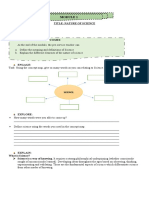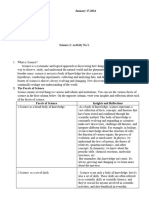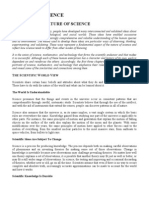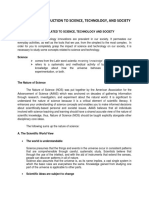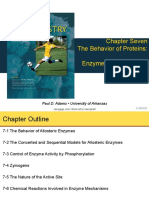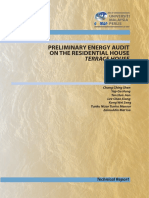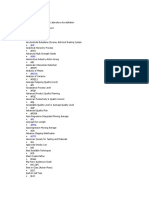NATURE OF SCIENCE
1. Science is wonderful world
- It deals with nature and natural phenomena. Science leads you to discover the mystery of a thin
electric wire, why the calls of your eyes are not on your lips, why you can communicate with
loved one across the miles through Face Tune
- Why a 225 Mriya, the world's largest aircraft with its more than five hundred passengers can fly
up in the air .
2. Science is evidence-based
- The maxim " see is to believe" deals with the observable, the verifiable, it deals with empirical
data.
3. Science has limits
- Not all reality is verifiable by the physical senses. The things of the spirit cannot be proven by
the physical senses and yet are us real as material reality.
- Antoine Exupery of the Little Prince said: "it is only with the heart that one can see rightty: What
is essential is invisible to the eye"
4. Science knowledge is inherently uncertain.
- The laws of Science are never viewed as fixed eternal truths. Even the most established and
universal laws of science are always regarded as temporary, subject to modification in the light of
new observation, experiments and analysis.
5. Science is dynamic and expanding body of knowledge
- This fundamental uncertainly makes science a dynamic and expanding body of knowledge.
- Science is a field of scientific inquiry.
6. Science is both a product and a process - It is information presented and also the way in
which the information has been collected
7. Science as a field of study
- Science demands eyes keen for observing, analytical, synthesizing and bias-free minds, traits
such as perseverance, diligence and sacrifice.
- A scientific study means long hours of meticulous study, arduous tesearch, sleepless nights, etc.
Understanding the nature of science helps to appreciate its strengths and limitations, fosters a
critical and evidence-based mindset, and promotes a deeper understanding of how scientific
knowledge is generated and refined over time.
B. GOAL OF SCIENCE
The goals of science can be broadly categorized into three main areas:
1. Description: Science aims to accurately describe and document the natural world and its
phenomena. This involves gathering empirical evidence, making observations, and cataloging
�information about the properties, behaviors, and interactions of various elements in the
universe.
2. Explanation: Science seeks to explain the how and why behind observed phenomena. It aims
to uncover the underlying principles, mechanisms, and processes that govern the natural world.
Scientists formulate theories and hypotheses to provide explanatory frameworks that can
account for observed patterns and phenomena, and they strive to test and refine these
explanations through experimentation and further investigation.
3. Prediction and Control: Another important goal of science is to make predictions and gain the
ability to exert control over natural phenomena. Through the development of scientific theories
and models, scientists can make predictions about future events or outcomes. These predictions
can be tested and verified, allowing for an understanding of cause and effect relationships and
providing the basis for technological advancements and practical applications.
By pursuing these goals, science enhances our understanding of the world, enables us to make
informed decisions, and drives innovation and progress in various fields. However, it's important
to note that science does not aim to answer every type of question. It is limited to investigating
natural phenomena and does not address questions related to values, morals, or supernatural
beliefs.
C. PROCESSES OF SCIENCE
The processes of science refer to the systematic methods and approaches used by scientists to
conduct research, investigate phenomena, and advance knowledge. These processes can be
described as follows:
1. Observation: The scientific process often begins with observation, where scientists carefully
and objectively observe natural phenomena or gather existing data relevant to their research
question. This step involves keenly noting and documenting relevant facts, patterns, and details.
2. Research question: Based on the observations, scientists formulate specific research questions
or develop hypotheses to explain the observed phenomena or to explore a particular area of
interest. These questions serve as the starting point for the scientific inquiry.
3. Hypothesis development: A hypothesis is a proposed explanation or prediction of an observed
phenomenon or a specific question arising from the research. It is typically based on existing
knowledge and is formulated as a testable statement that can be supported or refuted through
scientific investigation.
4. Experimentation or data collection: Scientists design and conduct experiments or gather data
to test their hypotheses. This involves planning and setting up controlled experiments, making
systematic measurements or observations, and collecting relevant data. The data collected
should be reliable, accurate, and reproducible.
�5. Analysis: Once data is collected, scientists analyze it using statistical and mathematical tools
and techniques. This involves organizing, interpreting, and making sense of the data to draw
meaningful conclusions about the hypothesis being tested.
6. Conclusion: Based on the analysis of the data, scientists arrive at conclusions regarding
whether the evidence supports or refutes the hypothesis. These conclusions may lead to further
research or the development of new questions and hypotheses.
7. Communication: Scientists communicate their findings through various means such as
scientific papers, conferences, presentations, or online platforms. This disseminates knowledge to
the scientific community and allows for peer-review and critical evaluation of the research.
Communication also helps to foster collaboration, build upon previous research, and inspire new
scientific inquiries.
These processes are not linear and often involve iteration, refinement, and modification.
Scientists engage in continuous learning, hypothesis testing, and revision of existing theories and
models as new evidence and insights emerge.





